September 2024
The global scleroderma therapeutics market size is accounted at USD 2.74 billion in 2025 and is forecasted to hit around USD 4.28 billion by 2034, representing a CAGR of 5.07% from 2025 to 2034. The North America market size was estimated at USD 1.23 billion in 2024 and is expanding at a CAGR of 5.13% during the forecast period. The market sizing and forecasts are revenue-based (USD Million/Billion), with 2024 as the base year.
The global scleroderma therapeutics market size was calculated at USD 2.61 billion in 2024 and is predicted to reach around USD 4.28 billion by 2034, expanding at a CAGR of 5.07% from 2025 to 2034. The demand for effective treatment solutions is driving the growth of the global scleroderma therapeutics market. The prevalence of rare diseases like scleroderma is increasing, and R&D activities are increasing, making the market more expanded. Additionally, government support and initiatives for R&D firms and healthcare are significantly fueling market expansion.
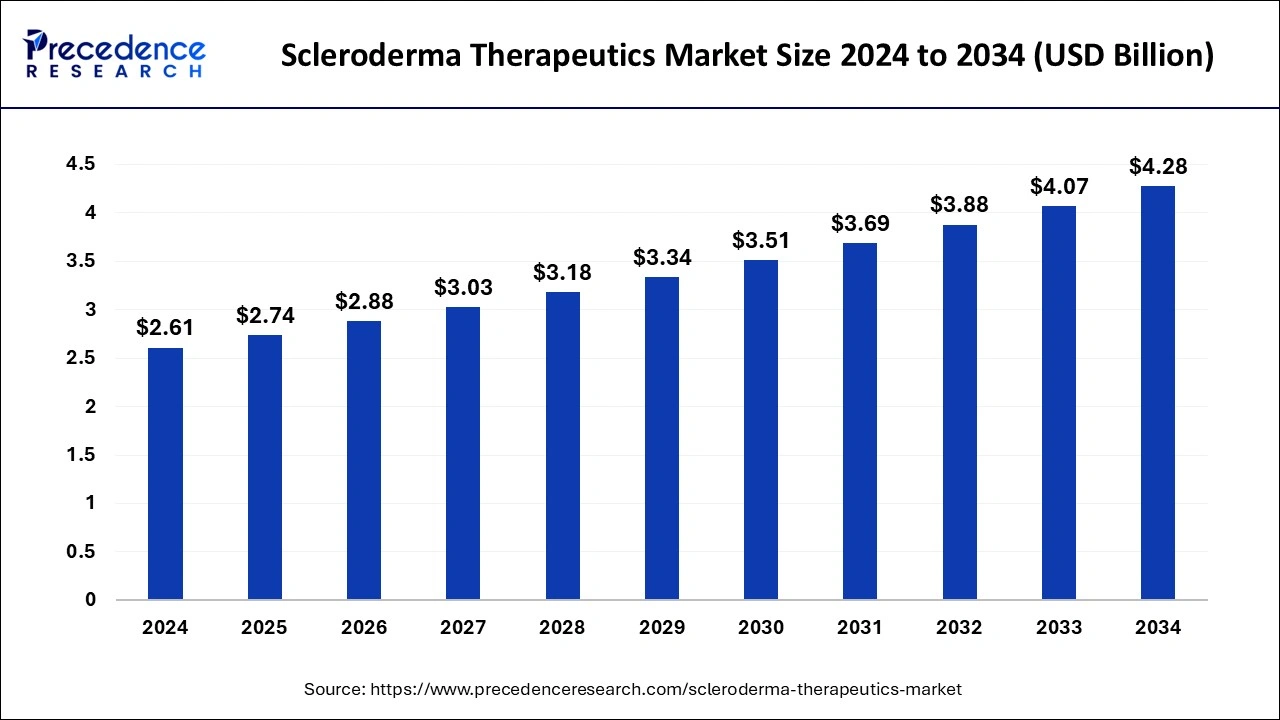
Artificial intelligence is taking the growth of the scleroderma therapeutics market to light by providing disease monitoring and diagnosis abilities. AI can analyze large databases and previous discoveries, which makes it easier for researchers to understand previous theories and reduce time investments. AI is able to provide all optimizing management processes as well as cost and time associated with research and manufacturing, which helps to build a better outlook plan.
AI allows for the generation of patient history, medical conditions, and genetic profiles, which helps to understand targeted treatments, and it becomes easier to develop effective treatments in the scleroderma therapeutics market. It is able to provide personalized medicine solutions by analyzing patient-relevant data and actual needs. The utilization of AI is making it easier to understand the manifestation and progression of the disease in the patient body. For instance, the utilization of AI in high-resolution computed tomography (HRCT) for treatments of systemic sclerosis is done with an understanding of lung disease. The benefits of AI in streamlining clinical trials, minimizing cost, and developing novel therapies are increasing the adoption of AI in the research and pharmaceutical sectors.
The U.S. scleroderma therapeutics market size was exhibited at USD 1.10 billion in 2024 and is projected to be worth around USD 1.84 billion by 2034, growing at a CAGR of 2.27% from 2025 to 2034.
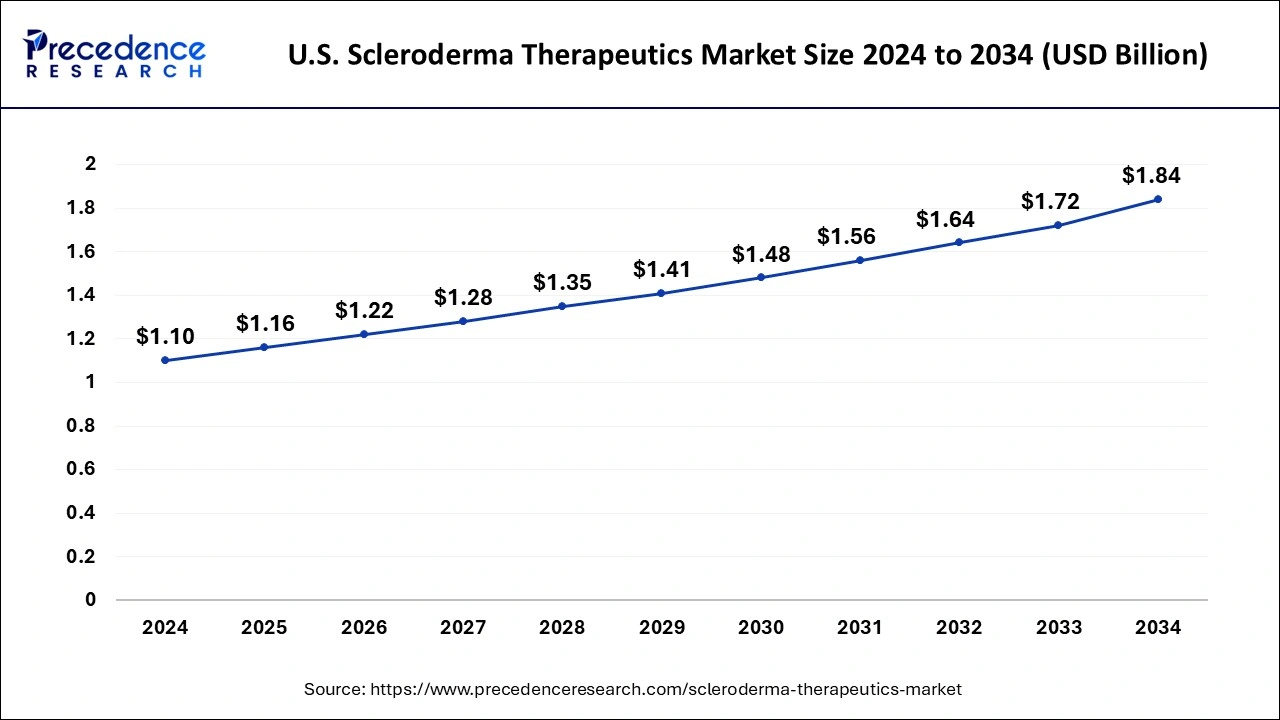
North America dominated the scleroderma therapeutics market in 2024 due to the high prevalence of the disease. North America is well known for the availability of established healthcare and pharmaceutical sectors. The growing prevalence of scleroderma disease in the region is driving the focus of regulatory frameworks to support and invest in research and development of novel treatment solutions. The region is contributing to research and development firms for innovative treatment solutions. Numerous research institutes and universities are driving innovation in the region.
The United States is leading the North American scleroderma therapeutics market due to the high prevalence of scleroderma disease in an aging population and the country's well-established healthcare sector. However, Canada witnesses significant growth in the market with a rapidly growing prevalence of the disease. Moreover, the presence of a regulatory framework like the Food and Drug Administration (FDA) is playing a crucial role in the regional market expansion.
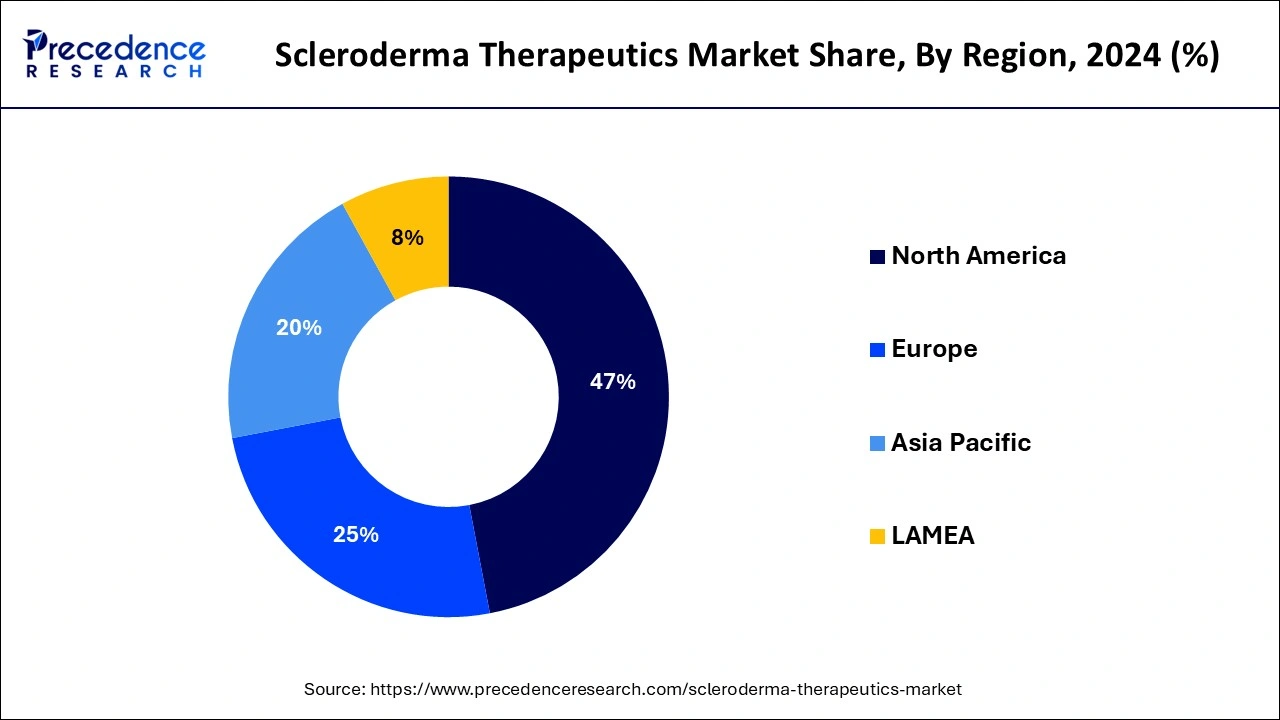
Asia Pacific is projected to host the fastest-growing scleroderma therapeutics market in the forecast period due to an increase in investment in the research and development sector. The surge of investment by countries in Japan, China, and India for new drug candidates, innovative therapies, and developments of advanced technologies is contributing to the growth of the market in the region. The prevalence of scleroderma in Asia has increased, leading to demand for effective treatments. Collaborations between hospitals and medical centers are generating room for market growth.
Japan is leading the Asia Pacific scleroderma therapeutics market due to the country's government focus and investment in the healthcare sector. However, India is anticipated to witness significant growth in the market due to increased patient populations and government investments in healthcare expenditure. Moreover, government support and initiatives to encourage R&D activities in pharmaceutical sectors for the development of orphan drugs are playing a crucial role in the market expansion.
Scleroderma is a rare condition in which overproduction of collagen causes a hardening of the skin, and in some cases, blood vessels and internal organs also get affected. The disease is four times more common in women than men. The growing prevalence of scleroderma disease is driving growth in the development of novel treatment solutions. The scleroderma therapeutics market is attributed to North America and Europe due to the increased prevalence of scleroderma in these regions. Moreover, expanded healthcare infrastructure and aging populations are fueling demands for effective treatments for sclerodermas. Growing investments by governments and pharmaceutical companies for the development of innovative treatments like antifibrotic agents.
Moreover, raising awareness about rare diseases means finding ways to cure diseases and prepositions. Growing focus on health and wellness, as well as government and regulatory initiatives for healthcare R&D and pharmaceutical sectors, are expected to boost the scleroderma therapeutics market in the upcoming period. Ongoing investments for stem cell and gene researchers are projected to develop cutting-edge solutions for scleroderma. Additionally, ongoing developments in innovative therapies and technology are likely to shed light on the industry's growth.
| Report Coverage | Details |
| Market Size by 2024 | USD 2.61 Billion |
| Market Size in 2025 | USD 2.74 Billion |
| Market Size in 2034 | USD 4.28 Billion |
| Market Growth Rate from 2025 to 2034 | CAGR of 5.07% |
| Dominating Region | North America |
| Fastest Growing Region | Asia Pacific |
| Base Year | 2024 |
| Forecast Period | 2025 to 2034 |
| Segments Covered | Drug Class, Indication, and Regions. |
| Regions Covered | North America, Europe, Asia-Pacific, Latin America, and Middle East & Africa. |
Increased research and development investments
The increasing prevalence of rare and critical diseases is prompting government and non-government bodies to prioritize investments in research and development of novel scleroderma therapeutics market solutions. Moreover, pharmaceutical biotechnology companies are also investing in research and development of cutting-edge treatments. With growing awareness of the disease among medical professionals and patients, the demand for effective treatment options has increased, leading to the encouraging development of innovative solutions.
Investment in research and development has led to the delivery of advanced therapies like immunosuppressants, antifibrotic agents, biologics, gene therapies, stem cells, and other small molecules, which help to manage the disease progress and also help to boost the immunity power of patients in the scleroderma therapeutics market. Moreover, the growing collaboration between pharmaceutical and biotechnology industries with universities and research teams is encouraging government and regulatory frameworks for further investments in the sectors.
Limited understanding of scleroderma’s pathophysiology
The limited understanding of pathophysiology is still a major restraint for the growth of the scleroderma therapeutics market. It is hard to identify effective targets to understand the diagnostics due to the involvement of immune cells by sclerodermas. Additionally, disease involves multiple pathways, which makes it hard for professionals to understand which pathway they should target. The development of antifibrotic treatments is still to be done due to a limited understanding of the mechanism of fibrosis. In recent studies, histopathological changes have been seen, which makes it more critical to understand the mechanisms of fibrosis. The lack of understanding of pathophysiology is hampering the development of effective treatments.
Developments of new biomarkers
The developments of novel biomarkers, like genetic, protein, and imaging biomarkers, hold potential in the scleroderma therapeutics market. The need for early detection and personalized treatments is leading to the development of genetic biomarkers. Similarly, protein biomarkers are being developed to monitor disease progress and response to treatments in the patient's body. Imaging biomarkers are important to assess skin and internal organ involvements. Imaging biomarkers like ultrasound and Magnetic Resonance Imaging are in high demand.
Biomarkers not only help to understand disease conditions and treatment processes but also help to develop novel scleroderma therapeutics market solutions. The need to improve patient outcomes is driving demands for biomarkers. Moreover, the growing investment by pharmaceutical and biotechnology companies in biomarker research and development is likely to transform the market. Additionally, government funding, support, and academic researchers are likely to contribute to the adoption and development of novel biomarkers to enhance treatment options for scleroderma.
The immunosuppressors segment contributed the highest share of the scleroderma therapeutics market in 2024. The immunosuppressors segment is leading the market due to its high demand for managing systemic scleroderma by suppressing the overactive immune response. Immunosuppressors help to reduce inflammation and fibrosis. Ongoing innovations in biologics and small-molecule immunosuppressors are the key reasons behind the expanding growth of the segment. Due to the ability to drive control over manifestations of scleroderma, like lung fibrosis and renal involvement, healthcare providers have increased the adoption of immunosuppressors in recent years. With the growing prevalence of scleroderma and the need for effective therapies in reducing disease progression, the segment is expected to continue dominating the market. Moreover, growing regulatory support and investments are driving the segment's success.
On the other hand, the endothelin receptor antagonist segment is expected to grow at a significant CAGR in the scleroderma therapeutics market during the forecast period. The growth of the segment is anticipated due to its growing adoption in healthcare due to its ability to block the actions of endothelin, a potent blood vessel constrictor, which develops the scleroderma condition. The receptor also effectively manages pulmonary arterial hypertension (PAH), a common complication of scleroderma. The endothelin receptor antagonist is being highlighted due to its ability to improve patients' exercise capacity and reduce the slow progression of disease in patients who are suffering from PAH. The adoption of some endothelin receptor antagonists like Bosentan, Ambrisentan, and Macitentan is high. With the growing need for the management of PAH and other complications of scleroderma, the adoption of segments is expected to boost in the forecast period.
The systemic scleroderma segment held the dominant share of the scleroderma therapeutics market in 2024. The segment growth is attributed to higher prevalence and greater severity of systemic scleroderma. The increased awareness and advanced diagnosis are driving the growth of the segment. Moreover, an aging population is contributing to the expansion. Systemic scleroderma improves morbidity and mortality by directly affecting inner organs like lungs and kidneys. The growing investments of pharmaceutical companies in the development of innovative treatments for systemic scleroderma.
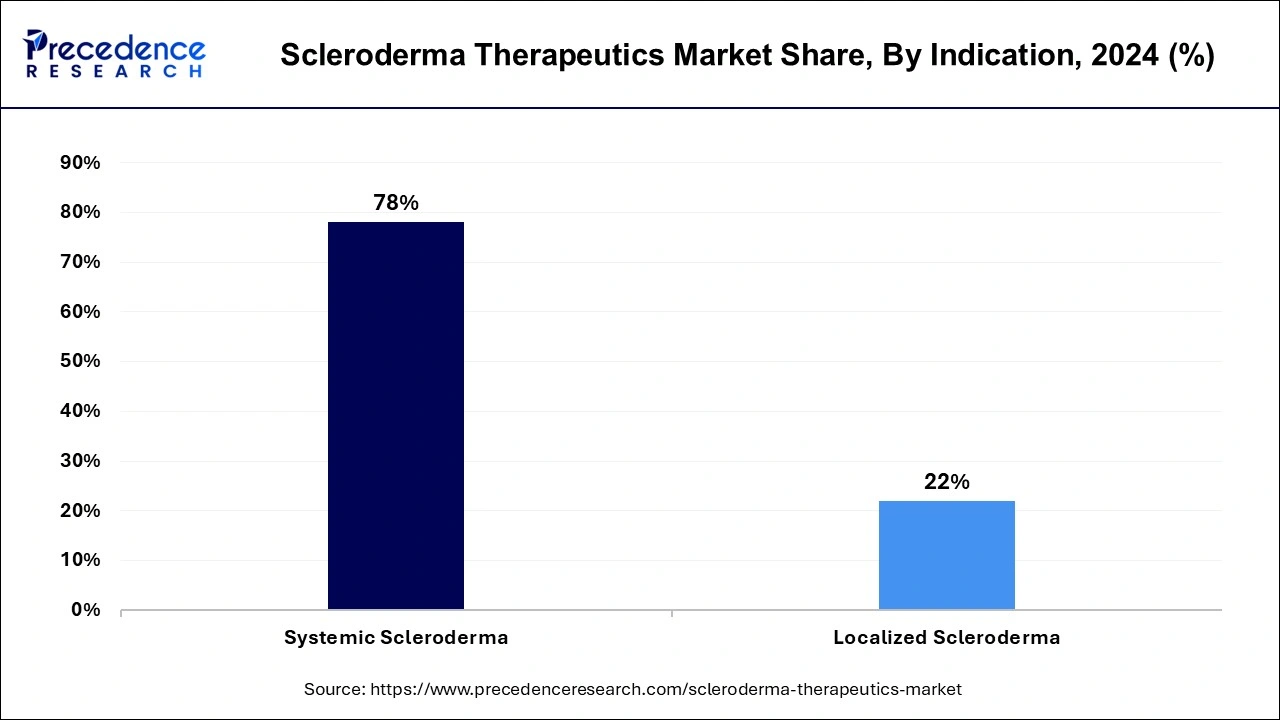
However, the localized scleroderma segment is anticipated to grow at the highest CAGR in the scleroderma therapeutics market during the forecast period. Localized scleroderma has properties of limited skin involvement. Localized scleroderma can mostly be treated by utilizing topical medications and phototherapy. Continuous innovations in the development of novel treatments for localized scleroderma, like biologics and small molecules, are fueling the segment expansion. Additionally, the ability of localized scleroderma to be cured by using systemic immunosuppressive therapy drives cutting-edge research in the treatments.
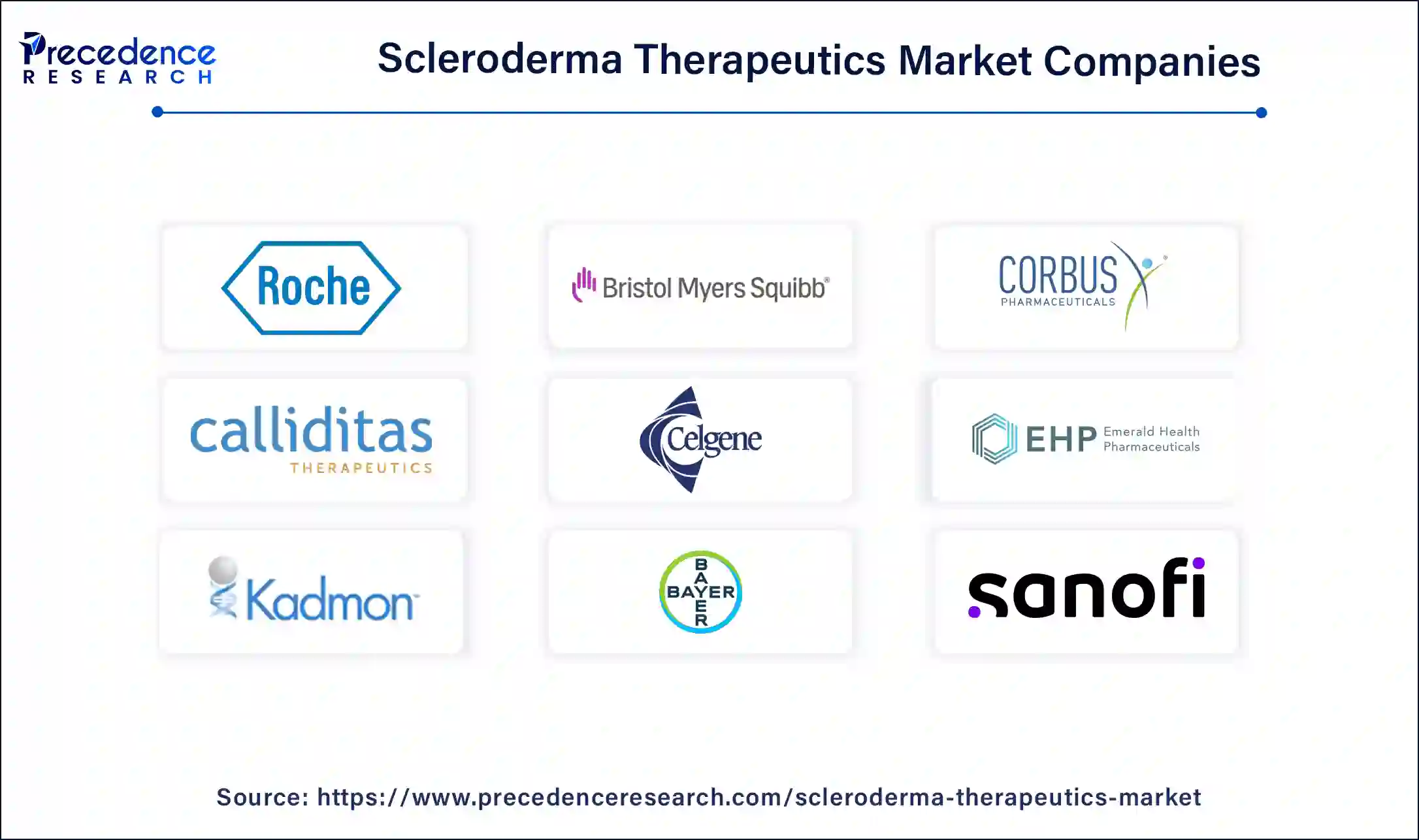
By Drug Class
By Indication
By Geography
For inquiries regarding discounts, bulk purchases, or customization requests, please contact us at sales@precedenceresearch.com
No cookie-cutter, only authentic analysis – take the 1st step to become a Precedence Research client
September 2024
August 2024
October 2024
March 2025